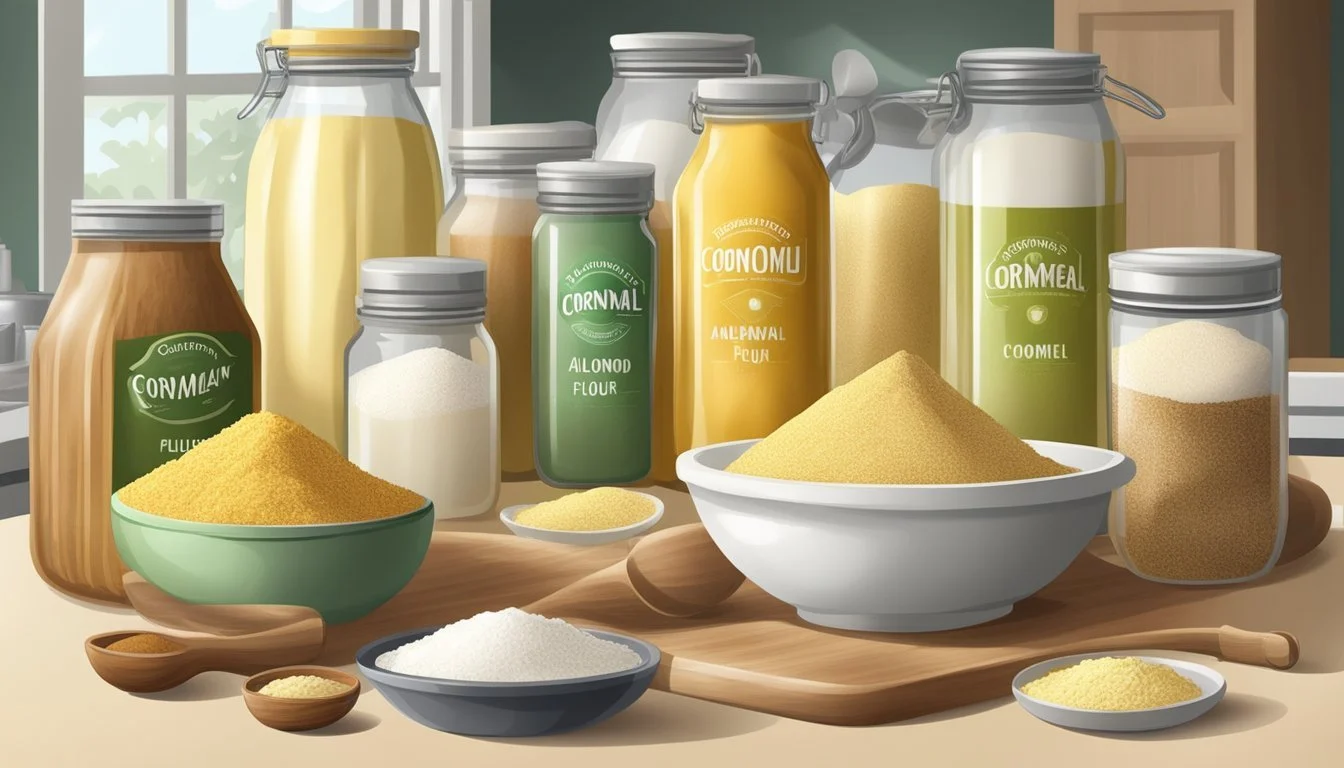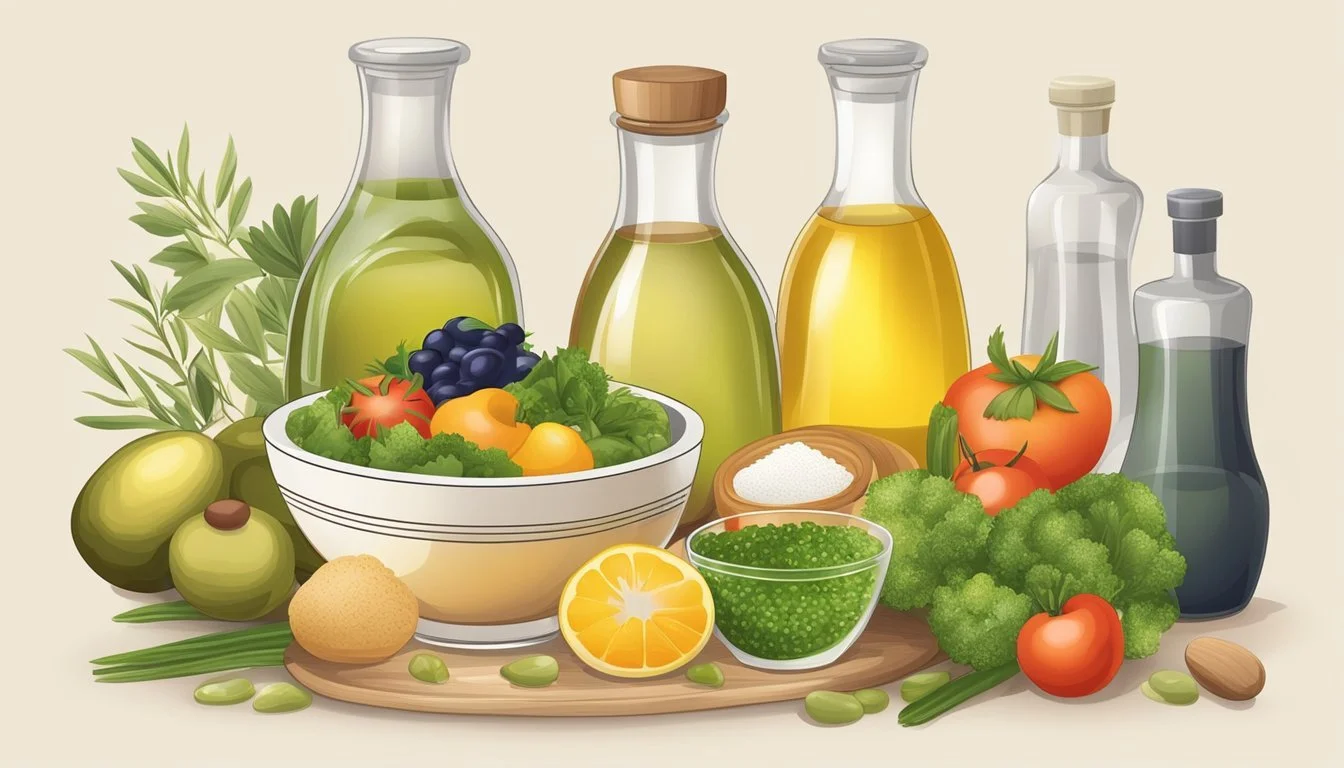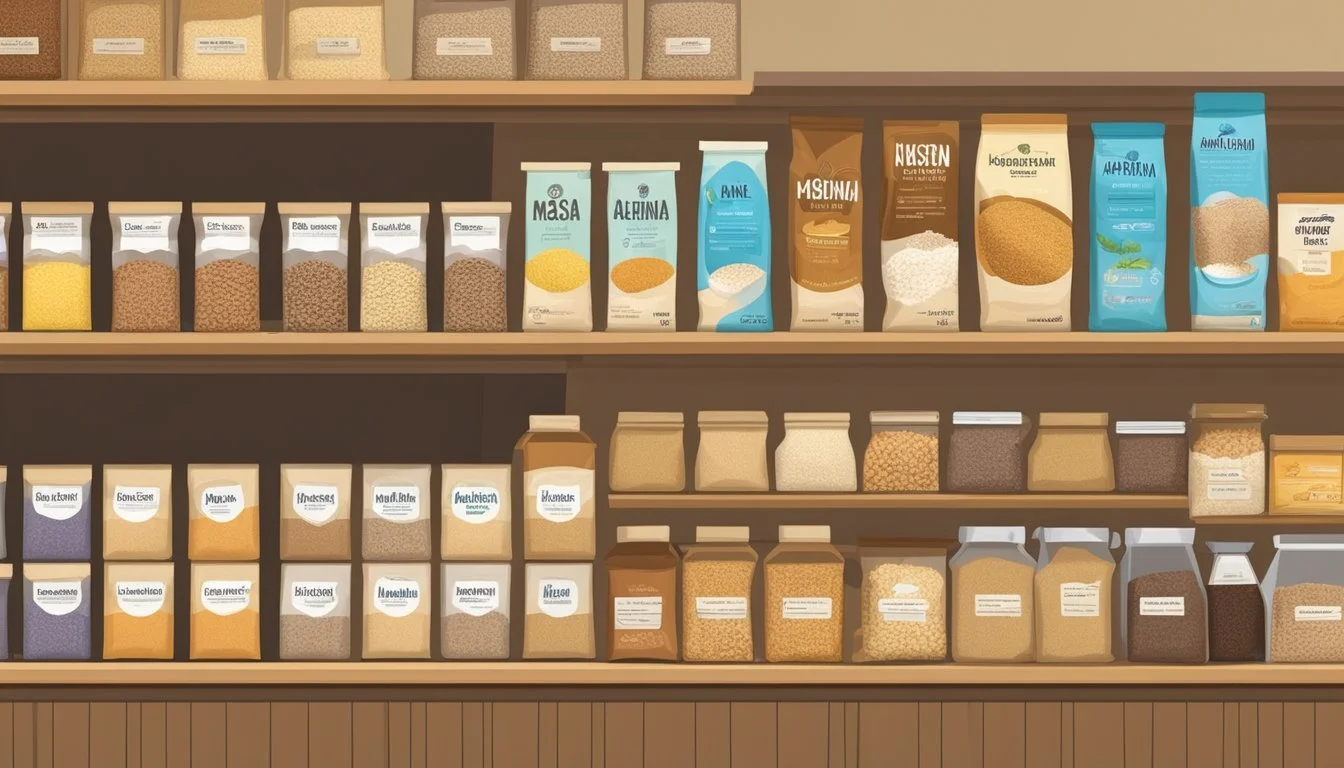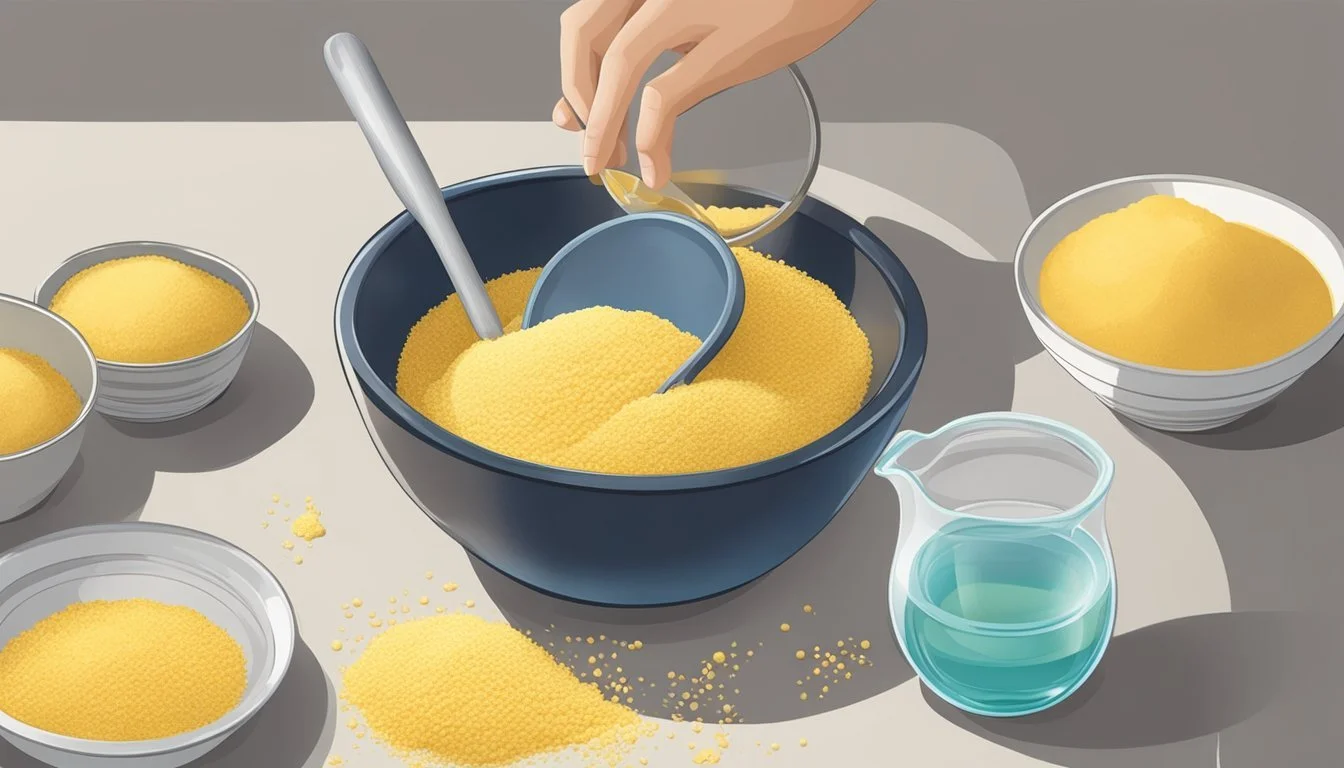Masa Harina Substitutes
Top Alternatives for Traditional Recipes
Masa harina, a staple in Latin American cuisine, is a fine corn flour treated with lime or wood-ash lye, a process known as nixtamalization, which enhances its nutritional profile and flavor. It is the foundation for dishes like tortillas, tamales, and arepas. However, in situations where masa harina is unavailable or someone seeks an alternative due to dietary restrictions or personal preferences, several substitutes can be used without significantly compromising the texture or taste of the original recipe.
Common alternatives to masa harina include corn flour, which, while not treated with lime, offers a similar consistency and can work well as a thickener in recipes. Other options such as cornmeal, ground from dried maize, provide a slightly grainier texture but can substitute masa harina, especially in dough-based preparations. For those looking for gluten-free options or a different flavor profile, arrowroot powder serves as a thickening agent and is preferable for sauces and jellies, although it lacks the distinctive taste of masa harina.
Understanding Masa Harina
Masa harina is a staple ingredient in Latin American cuisine, integral to making authentic Mexican dishes such as tortillas and tamales.
Origins and Uses
Masa harina, literally translated to "dough flour," is a fine, pale yellow flour made from ground nixtamalized corn. It is chiefly used in Mexican and Latin American cuisine to create corn tortillas, a core component of many Mexican dishes, as well as other foods like tamales, sopes, and arepas. The process of nixtamalization, where the corn is soaked and cooked in an alkaline solution, typically lime water, and then ground, endows masa harina with a distinctive flavor and increases the nutritional value by releasing niacin.
Nutritional Profile
The nutritional profile of masa harina is notable for its high carbohydrate content, with a moderate amount of fiber and minimal fat. It is also enriched with vitamins and minerals due to nixtamalization:
Fiber: Helps in digestion.
Niacin (Vitamin B3): Essential for the health of the nervous system and metabolism.
Calcium: Added during the nixtamalization process by the lime water.
Masa harina generally does not contain gluten, making it a suitable option for those with gluten intolerance or celiac disease, although it is essential to check the packaging for cross-contamination warnings if this is a concern. It remains an indispensable ingredient in Mexican and Latin American dishes, offering both nutritional benefits and authenticity in flavor.
Identifying Suitable Substitutes
When searching for a masa harina substitute, it is crucial to consider the desired texture, flavor compatibility, and whether gluten is a concern. The following subsections explore alternatives that closely mimic the properties of masa harina in various dishes.
Corn-Based Alternatives
Corn-based substitutes are the most similar in flavor and composition to masa harina. Cornmeal and corn flour are primary alternatives; they maintain the grain's essence but differ slightly in texture and flavor. Cornmeal is coarser and can replace masa harina in a 1:1 ratio for preparations requiring a grainier texture. Corn flour, on the other hand, is finely ground and ideal for a smoother finish in sauces and doughs.
Ground Hominy: Created from dried corn kernels that have been treated with an alkali, ground hominy echoes the taste of masa harina.
Polenta: While polenta is coarser, it can substitute for masa harina in recipes where a robust texture is acceptable.
Grits: Typically from hominy, grits are another coarse meal, suitable for dishes that accommodate a grittier consistency.
Wheat and Other Grain Substitutes
For those without gluten sensitivities, all-purpose flour can sometimes act as a thickener, although it will not replicate masa harina's distinct corn flavor. Rice flour, a grain-based, gluten-free option, can be used for those with gluten restrictions, though it lacks the characteristic corn taste.
Flour: Wheat-based flour can be used when the corn flavor is not essential, as it offers a different taste and texture profile.
Gluten-Free Options
Gluten-free alternatives are important for individuals with celiac disease or gluten sensitivity. Corn starch provides excellent thickening properties for gravies and soups but does not impart the corn flavor of masa harina.
Arrowroot Powder: This is flavorless and can give a clear, glossy finish, perfect for jellies and some baked goods.
Rice Flour: Also gluten-free, it serves as a thickening agent, with a different texture from masa harina but useful in a pinch.
Substitutes in Cooking and Baking
When it comes to cooking and baking, finding viable substitutes for masa harina is essential for achieving similar textures and flavors in traditional Latin American dishes. These substitutes not only preserve the cultural authenticity but also cater to instances when masa harina is not readily available.
Making Tortillas and Tamales
For tortillas and tamales, where masa harina acts as the primary ingredient in the dough, ground corn tortillas or corn taco shells can serve as substitutes. They can be ground into a fine powder and used in place of masa harina to create a comparable corn dough. To mimic the distinctive flavor that comes from masa harina's processing with calcium hydroxide, corn flour can be similarly treated or blended with a pinch of lime.
Corn Flour: Closest substitute in flavor and texture.
Ground Tortillas/Taco Shells: Ideal for their similar corn taste and when reconstituted can replicate the dough-like consistency.
Thickening Soups and Sauces
Masa harina's role as a thickener in soups and sauces can be substituted with cornstarch or arrowroot powder for a similar effect without altering flavor significantly. Cornmeal and polenta can also be used, providing a slightly grainier texture.
Cornstarch or Arrowroot Powder: Use for a smoother texture as a thickening agent.
Cornmeal or Polenta: These alternatives offer a coarser texture, ideal for dishes that can accommodate a heartier feel.
Baking Considerations
When baking goods that traditionally incorporate masa harina, such as pupusas or cornbread, it is important to consider the texture and weight of the substitutes. Wheat flour may not be a good substitute, as the fundamental difference in grain type can affect both texture and flavor. Instead, one can opt for alternatives that maintain the integrity of the original dish.
Corn Flour: Offers a lighter texture suited for baked goods.
Ground Corn Tortillas: Can be used for their textural properties to simulate masa harina in baked recipes.
It is important to adjust the liquid content when using these substitutes to maintain the moisture level and binding properties expected in corn-based baked dishes.
Health and Dietary Aspects of Substitutes
When considering substitutes for masa harina, it’s important to look at both the nutritional content and the suitability of these alternatives for various diets. Each substitute comes with its own set of nutrients and dietary implications.
Nutritional Comparison
Substitutes for masa harina vary in their nutritional composition. Here's how some common alternatives stack up against each other in terms of fiber, protein, calcium, and iron:
Substitute Fiber (per 100g) Protein (per 100g) Calcium (per 100g) Iron (per 100g) Corn Flour 7.3g 6.93g 2mg 2.71mg Arrowroot Powder 3.4g 0.3g 6mg 2.22mg Cornstarch 0.9g 0.26g 2mg 0.47mg Ground Flaxseed 27.3g 18.29g 255mg 5.73mg
Ground flaxseed stands out for its high fiber and omega-3 content, which can be beneficial for weight loss and overall health. However, it differs significantly from masa harina in texture and flavor.
Diet-Specific Substitutes
Dietary restrictions can guide the choice of substitute for masa harina.
Keto Diet: For individuals following a keto diet that requires low-carb ingredients, neither corn flour nor traditional masa harina is suitable. Ground flaxseed, with its lower carbohydrate content, may be a more appropriate choice.
Gluten-Free Diets: Masa harina is naturally gluten-free, so substitutes like corn flour and arrowroot powder are ideal for those avoiding gluten.
Dairy-Free Diets: Masa harina and its substitutes typically do not contain dairy products, making them suitable for dairy-free diets.
Vegan Diets: Those comprehending vegan recipes, like empanadas, can safely use masa harina substitutes such as corn flour or arrowroot powder, which contain no animal products.
In summary, the selection of a substitute for masa harina should be driven not only by culinary needs but also by health and dietary considerations.
Preparing Substitutes at Home
For individuals looking to replicate the unique qualities of masa harina, preparing substitutes at home can be a satisfying venture. It involves processes like nixtamalization to achieve a similar flavor and texture profile that this Mexican flour is known for.
Home Nixtamalization
To create a masa harina alternative from scratch, one could start with nixtamalization — the process where corn is treated with an alkaline solution, commonly lime water, then washed, and hulled to produce nixtamal for making fresh masa. Dried hominy can be substituted for corn to skip the initial nixtamalization steps. A food processor or a traditional grain mill can grind the nixtamal into corn dough. If using a grinder or a metate, ensure the consistency matches that of fresh masa.
Ingredients and Tools Needed:
Corn or dried hominy
Lime (Calcium Hydroxide)
Water
Grinder/food processor/grain mill/metate
Instructions:
Soak corn in lime water overnight.
Rinse thoroughly and rub off the hulls.
Grind the treated corn into a fine paste using your chosen tool.
DIY Doughs and Mixes
Creating DIY doughs and mixes as a masa harina replacement can be done by blending canned hominy or corn into a slurry using a food processor. In some cases, lime juice may be added to enhance flavor, though it is not a traditional nixtamalization agent. The resulting mixture may be referred to as fresh masa preparada. For a coarser texture, akin to mexican flour, use a grain mill to process the mix into a grainier substance.
Ingredients and Tools Needed:
Canned hominy or corn
Lime juice (optional)
Food processor/grain mill
Instructions:
Blend hominy or corn until it achieves the desired consistency.
For added tartness, incorporate a few drops of lime juice into the mixture.
Shopping for Masa Harina Substitutes
When seeking alternatives to masa harina, shoppers should consider both the flavor profile and textural qualities that the substitute will bring to the dish they are preparing.
Retail Selection Tips
When perusing a retail environment for masa harina substitutes, one should first examine the products available in the international aisle, specifically the Latin American section. It is there that one might find corn flour, which resembles masa harina most closely. Shoppers should look for labels indicating the presence of calcium hydroxide, an element crucial in the traditional preparation of masa harina which imparts a distinctive taste. Additionally, products labeled as non-GMO or organic might be of interest to those favoring a more natural approach.
For dishes requiring thickening, arrowroot powder provides an excellent alternative and is often positioned with other thickening agents like cornstarch. A fine, paleo-friendly substitute, arrowroot powder is flavorless, and therefore does not alter the taste profile of the food.
Finding Substitutes in Stores or Markets
At a Latin American grocery store, customers have a higher chance of finding authentic substitutes for masa harina such as masa preparada or freshly ground hominy. When shopping for masa harina substitutes, looking for texture compatibility is key. Cornmeal and dry polenta can serve well in recipes calling for the grainy texture typical of masa harina.
If one is preparing a dish that calls for a salty flavor, integrating kosher salt into the substitute blend can help achieve a desired taste, especially when using plainer alternatives like arrowroot powder or corn flour.
Consumers should always check the package for recommended substitution ratios to ensure proper consistency and flavor balance in their culinary endeavors.
Culinary Techniques with Substitutes
In the absence of masa harina, alternatives require adjustments in culinary techniques to achieve near-authentic flavors and textures in traditional dishes such as tamales, tostadas, and other staples of Latin American cuisine.
Achieving Authentic Flavors and Textures
When substituting masa harina, one primary goal is to closely mimic its unique flavor and texture. Corn flour, with a finer texture, can serve as a direct substitute and is particularly effective for making soft dough balls for tamales or empanadas. The chef should note that, unlike masa harina, corn flour has not undergone the nixtamalization process and therefore lacks the distinct tartness.
To remedy this, a small amount of lime juice or vinegar may be added to the recipe. Additionally, chefs might use corn tortillas, ground into a powder, as a 1:1 substitute to provide the necessary texture and inherent flavor for dishes such as gorditas or tlacoyos.
Adjusting Recipes and Ratios
Using substitutes means altering recipe ratios for consistency. For instance, with canned hominy, which can replace masa harina, chefs would reduce the water content in the recipe since canned hominy, once blended, will contribute additional moisture to the dough.
Polenta, a coarser grind of cornmeal, is another viable substitute that works well in rustic creations where a grainier texture is acceptable. Chefs typically pair it with heartier fillings. Below is a suggested ratio adjustment for common masa harina substitutes:
Substitute Texture Comparison Suggested Ratio Best Used For Corn Flour Finer 1:1 with less liquid Dough balls, Tlacoyos Ground Corn Tortillas Comparable 1:1 Gorditas, Tostadas Canned Hominy (blended) Softer 1:1 with less liquid Tamales, Empanadas Polenta Coarser 1:1 Hearty Fillings, Stews
For crispy textures, such as with tortilla chips or tostadas, chefs can use corn tortilla chips, crushed finely, as a crunchy coating or as part of the dough mixture, but should be cautious not to overpower the main ingredients.






